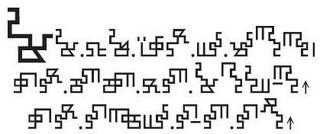Mandombé

I will soon read further on the mirrored letters of Tibetan and Phags-pa. They are still the earliest examples of reflections being used to create new letters that I am aware of and that is a history I am eager to pursue.
In the meantime, I would like to post about Mandombé. For this post I will be depending on information in part only available in Wikipedia. There are times when we just have to eat our words, for some of us this comes sooner rather than later.
First, thanks to the person who sent me this link with much related information - all of it very interesting. I tried to reply but my email client is suffering from an overactive spam blocker and I can't respond at this moment.
This Wikipedia page on Mandombé gives detailed information of how to read this script. The article was written by Denis Jacquerye and comes recommended by Don Osborn of Bisharat.net.
Since I am constantly reminding myself to return to the visual aspects of a script as the focus rather than its linguistics aspects, which I can't resist but enough of that, here is a page of art inspired by the Mandombé script. It is important to see how this script is understood visually by its users.
Matters of note related to this script. It was invented by David Wabeladio in 1978 in the Congo and makes use of rotations to create both vowels and consonants. Scan down this page to see Wabeladio writing in Mandombé on a blackboard.
This script will lead into the very interesting question of whether transformations and rotations make a script difficult to read - that is more difficult to read than say Chinese or Arabic.
More information here and here.

0 Comments:
Post a Comment
<< Home